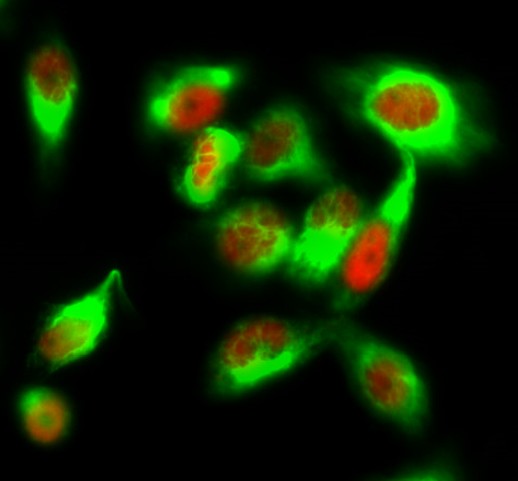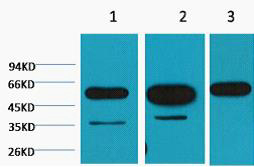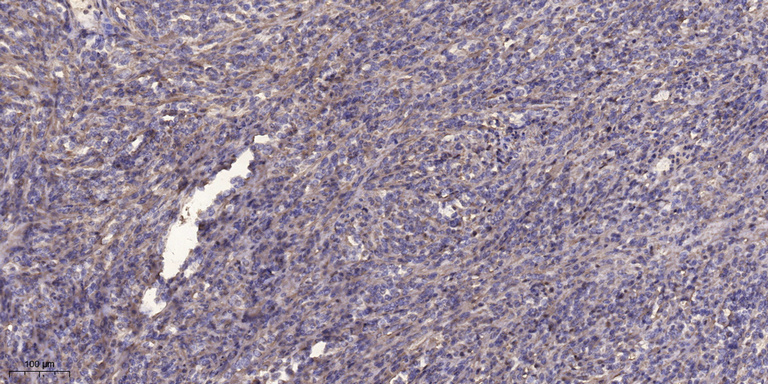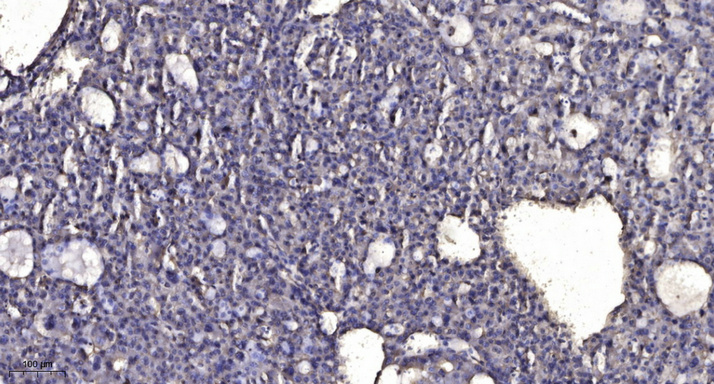β-tubulin Monoclonal Antibody(M7)
- Catalog No.:YM3135
- Applications:WB;IF
- Reactivity:Human;Mouse;Rat
- Target:
- Tubulin β
- Fields:
- >>Phagosome;>>Gap junction;>>Alzheimer disease;>>Parkinson disease;>>Amyotrophic lateral sclerosis;>>Huntington disease;>>Prion disease;>>Pathways of neurodegeneration - multiple diseases;>>Pathogenic Escherichia coli infection;>>Salmonella infection
- Gene Name:
- TUBB3
- Protein Name:
- Tubulin beta-3 chain
- Human Gene Id:
- 10381
- Human Swiss Prot No:
- Q13509
- Mouse Gene Id:
- 22152
- Mouse Swiss Prot No:
- Q9ERD7
- Rat Gene Id:
- 246118
- Rat Swiss Prot No:
- Q4QRB4
- Immunogen:
- Synthetic Peptide of β-tubulin
- Specificity:
- The antibody detects endogenousβ-tubulin protein.
- Formulation:
- PBS, pH 7.4, containing 0.5%BSA, 0.02% sodium azide as Preservative and 50% Glycerol.
- Source:
- Monoclonal, Mouse
- Dilution:
- WB 1:5000 -10000 IF 1:100-200
- Purification:
- The antibody was affinity-purified from mouse ascites by affinity-chromatography using specific immunogen.
- Concentration:
- 1 mg/ml
- Storage Stability:
- -15°C to -25°C/1 year(Do not lower than -25°C)
- Other Name:
- TUBB3;TUBB4;Tubulin beta-3 chain;Tubulin beta-4 chain;Tubulin beta-III
- Observed Band(KD):
- 55kD
- Background:
- tubulin beta 3 class III(TUBB3) Homo sapiens This gene encodes a class III member of the beta tubulin protein family. Beta tubulins are one of two core protein families (alpha and beta tubulins) that heterodimerize and assemble to form microtubules. This protein is primarily expressed in neurons and may be involved in neurogenesis and axon guidance and maintenance. Mutations in this gene are the cause of congenital fibrosis of the extraocular muscles type 3. Alternate splicing results in multiple transcript variants. A pseudogene of this gene is found on chromosome 6. [provided by RefSeq, Oct 2010],
- Function:
- domain:The highly acidic C-terminal region may bind cations such as calcium.,function:Receptor for MSH (alpha, beta and gamma) and ACTH. The activity of this receptor is mediated by G proteins which activate adenylate cyclase.,function:Tubulin is the major constituent of microtubules. It binds two moles of GTP, one at an exchangeable site on the beta chain and one at a non-exchangeable site on the alpha-chain.,polymorphism:Genetic variations in MC1R are associated with variation in skin/hair/eye pigmentation type 2 (SHEP2) [MIM:266300]. Hair, eye and skin pigmentation are among the most visible examples of human phenotypic variation, with a broad normal range that is subject to substantial geographic stratification. In the case of skin, individuals tend to have lighter pigmentation with increasing distance from the equator. By contrast, the majority of variation in human eye and hair col
- Subcellular Location:
- Cytoplasm, cytoskeleton . Cell projection, growth cone . Cell projection, lamellipodium . Cell projection, filopodium .
- Expression:
- Expression is primarily restricted to central and peripheral nervous system. Greatly increased expression in most cancerous tissues.
p21-activated kinase 4 as a switch between caspase-8 apoptosis and NF-κB survival signals in response to TNF-α in hepatocarcinoma cells. BIOCHEMICAL AND BIOPHYSICAL RESEARCH COMMUNICATIONS 2018 Aug 24 WB Human SK-Hep1 and HepG2
Interventional effect of Codonopsis pilosula oligosaccharides against d-galactose-induced aging in SD rats via suppression of oxidative stress, inflammation, and apoptosis. JOURNAL OF CARBOHYDRATE CHEMISTRY 2021 Jun 17 WB Rat Liver
- June 19-2018
- WESTERN IMMUNOBLOTTING PROTOCOL
- June 19-2018
- IMMUNOHISTOCHEMISTRY-PARAFFIN PROTOCOL
- June 19-2018
- IMMUNOFLUORESCENCE PROTOCOL
- September 08-2020
- FLOW-CYTOMEYRT-PROTOCOL
- May 20-2022
- Cell-Based ELISA│解您多样本WB检测之困扰
- July 13-2018
- CELL-BASED-ELISA-PROTOCOL-FOR-ACETYL-PROTEIN
- July 13-2018
- CELL-BASED-ELISA-PROTOCOL-FOR-PHOSPHO-PROTEIN
- July 13-2018
- Antibody-FAQs
- Products Images

- Immunofluorescence analysis of Hela cell. 1,ERK 1/2 (phospho Tyr222/205) Polyclonal Antibody(red) was diluted at 1:200(4° overnight). β-tubulin Monoclonal Antibody(M7)(green) was diluted at 1:200(4° overnight). 2, Goat Anti Rabbit Alexa Fluor 594 Catalog:RS3611 was diluted at 1:1000(room temperature, 50min). Goat Anti Mouse Alexa Fluor 488 Catalog:RS3208 was diluted at 1:1000(room temperature, 50min).

- Western blot analysis of 1) Hela, 2) Mouse Brain tissue, 3) Rat Brain tissue, diluted at 1:5000.

- IF analysis of Hela with antibody (Left) and DAPI (Right) diluted at 1:100.


